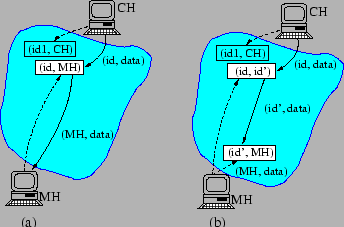 |

 |
While choosing a trigger ![]() at an
at an ![]() server close to the MH
improves the routing and handoff efficiency, this choice would reveal
(to some extent) the location of the MH. To avoid this problem, the MH can
choose
server close to the MH
improves the routing and handoff efficiency, this choice would reveal
(to some extent) the location of the MH. To avoid this problem, the MH can
choose ![]() such that the trigger is stored at an
such that the trigger is stored at an ![]() server close to
the CH instead of itself. This would result in a low latency stretch
without compromising the MH's location privacy. Let
server close to
the CH instead of itself. This would result in a low latency stretch
without compromising the MH's location privacy. Let ![]() be the
trigger advertised by the CH to the MH (see
Figure 4(a)). Assuming that the CH chooses this
trigger close to itself, the MH can simply choose
be the
trigger advertised by the CH to the MH (see
Figure 4(a)). Assuming that the CH chooses this
trigger close to itself, the MH can simply choose ![]() to share the
first 128 bits with
to share the
first 128 bits with ![]() . This is because with
. This is because with ![]() , all triggers
whose identifiers share the same 128-bit prefix are stored at the same
, all triggers
whose identifiers share the same 128-bit prefix are stored at the same
![]() server [6].
server [6].
To also allow fast handoff, the MH can use two triggers, one of the
form ![]() 5inserted near the CH, and one of the form
5inserted near the CH, and one of the form ![]() inserted close to itself (see Figure 4(a)). Note
that this change is transparent to the CH, i.e., the CH will still
send packets of the form
inserted close to itself (see Figure 4(a)). Note
that this change is transparent to the CH, i.e., the CH will still
send packets of the form ![]() to the MH. Because the CH
does not need to know
to the MH. Because the CH
does not need to know ![]() , the location privacy of the MH is
ensured. Moreover, the choice of
, the location privacy of the MH is
ensured. Moreover, the choice of ![]() and
and ![]() ensures a low latency
stretch, and enables the MH to do fast handoff by updating trigger
ensures a low latency
stretch, and enables the MH to do fast handoff by updating trigger ![]() .
.
If both end-points require location privacy, they can
choose completely random ![]() servers. The flexibility of
servers. The flexibility of ![]() allows
each application to make the tradeoff between location privacy and
routing efficiency as desired.
allows
each application to make the tradeoff between location privacy and
routing efficiency as desired.